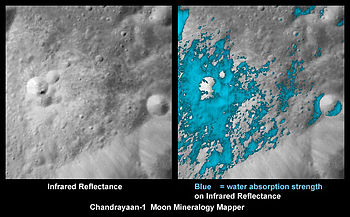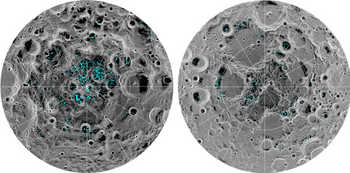 Global Information
Global InformationLunar water information



Lunar water is water that is present on the Moon. Diffuse water molecules in low concentrations can persist at the Moon's sunlit surface, as discovered by the SOFIA observatory (an 80/20 joint project of NASA and the German Aerospace Centre, DLR) in 2020.[1] Gradually, water vapor is decomposed by sunlight, leaving hydrogen and oxygen lost to outer space. Scientists have found water ice in the cold, permanently shadowed craters at the Moon's poles.[2][3] Water molecules are also present in the extremely thin lunar atmosphere.[4]
NASA's Ice-Mining Experiment-1 (set to launch on the PRIME-1 mission no earlier than late 2024) is intended to answer whether or not water ice is present in usable quantities in the southern polar region.[5]
Water (H2O) and the related hydroxyl group (-OH) exist in forms chemically bonded as hydrates and hydroxides to lunar minerals (rather than free water), and evidence strongly suggests that this is the case in low concentrations as for much of the Moon's surface.[6] In fact, of surface matter, adsorbed water is calculated to exist at trace concentrations of 10 to 1000 parts per million.[7] Inconclusive evidence of free water ice at the lunar poles had accumulated during the second half of the 20th century from a variety of observations suggesting the presence of bound hydrogen.
On 18 August 1976, the Soviet Luna 24 probe landed at Mare Crisium, took samples from the depths of 118, 143, and 184 cm of the lunar regolith, and returned them to Earth. In February 1978, laboratory analysis of these samples showed that they contained 0.1% (1,000 ppm) water by mass.[8][9] Spectral measurements showed minima near 3, 5, and 6 μm, distinctive valence-vibration bands for water molecules, with intensities two or three times larger than the noise level.[10]
On 24 September 2009, the Indian Space Research Organisation's Chandra's Altitudinal Composition Explorer (CHACE) and NASA's Moon Mineralogy Mapper (M3) spectrometer on board the Chandrayaan-1 probe had detected absorption features near 2.8–3.0 μm on the surface of the Moon.[11] On 14 November 2008, Chandrayaan-1 released the Moon Impact Probe to impact the Shackleton crater, which helped confirm the presence of water ice. For silicate bodies, such features are typically attributed to hydroxyl- and/or water-bearing materials.[12] In August 2018, NASA confirmed that M3 showed water ice is present on the surface at the Moon poles.[13][14] Water in concentrations of 100 to 412 parts per million (0.01%-.042%) was confirmed to be on the sunlit surface of the Moon by the SOFIA observatory on October 26, 2020.[15]
Water may have been delivered to the Moon over geological timescales by the regular bombardment of water-bearing comets, asteroids, and meteoroids[16] or continuously produced in situ by the hydrogen ions (protons) of the solar wind impacting oxygen-bearing minerals.[17]
The search for the presence of lunar water has attracted considerable attention and motivated several recent lunar missions, largely because of water's usefulness in rendering long-term lunar habitation feasible.[18]
- ^ "NASA - SOFIA discovers water on sunlit surface of the Moon". NASA. 26 October 2020.
- ^ Pinson, Jerald (2020-11-20). "Moon May Hold Billions of Tons of Subterranean Ice at Its Poles". Eos. 101. doi:10.1029/2020eo151889. ISSN 2324-9250. S2CID 229487508.
- ^ "Ice Confirmed at the Moon's Poles". NASA Jet Propulsion Laboratory (JPL). Retrieved 2023-04-13.
- ^ "Is There an Atmosphere on the Moon? | NASA". nasa.gov. 7 June 2013. Retrieved 2015-05-25.
- ^ "NASA - NSSDCA - Spacecraft - Details".
- ^ Lucey, Paul G. (23 October 2009). "A Lunar Waterworld". Science. 326 (5952): 531–532. Bibcode:2009Sci...326..531L. doi:10.1126/science.1181471. PMID 19779147. S2CID 642214.
- ^ Clark, Roger N. (23 October 2009). "Detection of Adsorbed Water and Hydroxyl on the Moon". Science. 326 (5952): 562–564. Bibcode:2009Sci...326..562C. doi:10.1126/science.1178105. PMID 19779152. S2CID 34849454.
- ^ Akhmanova, M; Dement'ev, B; Markov, M (February 1978). "Water in the regolith of Mare Crisium (Luna-24)?". Geokhimiya (in Russian) (285).
- ^ Akhmanova, M; Dement'ev, B; Markov, M (1978). "Possible Water in Luna 24 Regolith from the Sea of Crises". Geochemistry International. 15 (166).
- ^ Markov, M.N.; Petrov, V.S.; Akhmanova, M.V.; Dement'ev, B.V. (1980). "Infrared reflection spectra of the moon and lunar soil". In Rycroft, M.J. (ed.). Space Research Proceedings of the Open Meetings of the Working Groups on Physical Sciences of the Twenty-Second Plenary Meeting of COSPAR. Twenty-Second Plenary Meeting of COSPAR. COSPAR Colloquia Series. Vol. 20. Bangalore, India (published 1 January 1980). pp. 189–192. doi:10.1016/S0964-2749(13)60040-2. ISBN 978-0-08-024437-2.
Fig. 3 shows the diffuse reflection spectra and scattering polar diagrams for two wavelengths (2.2 and 4.5 μm) for samples returned to Earth by Luna 24... Fig. 3 also shows slight minima near 3, 5 and 6 μm. These absorption bands are rather well identified by the valence bands and vibrations of a water molecule. The intensity of these bands (two or three times larger than the noise level) is a maximum for the sample taken from the depth of 143 cm, and becomes less at 184 cm; it is comparable with the noise level at 118 cm. A comparison with basalt spectra with known water concentrations allows an estimate to be made of the water content in the sample of 0.1% (1,000 ppm) at a depth of 143 cm. We have taken all the necessary precautions to protect the samples of lunar soil from atmospheric water, and thus have confidence in our results. The 5.5 to 7.5 μm structure in the reflection spectrum obtained by Saljut 5 may also favour the lunar origin of the water.
- ^ "In Depth | Chandrayaan 1". NASA Solar System Exploration. Retrieved 2023-08-21.
- ^ Pieters, C. M.; Goswami, J. N.; Clark, R. N.; Annadurai, M.; Boardman, J.; Buratti, B.; Combe, J. -P.; Dyar, M. D.; Green, R.; Head, J. W.; Hibbitts, C.; Hicks, M.; Isaacson, P.; Klima, R.; Kramer, G.; Kumar, S.; Livo, E.; Lundeen, S.; Malaret, E.; McCord, T.; Mustard, J.; Nettles, J.; Petro, N.; Runyon, C.; Staid, M.; Sunshine, J.; Taylor, L. A.; Tompkins, S.; Varanasi, P. (2009). "Character and Spatial Distribution of OH/H2O on the Surface of the Moon Seen by M3 on Chandrayaan-1". Science. 326 (5952): 568–572. Bibcode:2009Sci...326..568P. doi:10.1126/science.1178658. PMID 19779151. S2CID 447133.
- ^ "Ice Confirmed at the Moon's Poles". NASA Jet Propulsion Laboratory (JPL). Retrieved 2023-04-13.
- ^ Water on the Moon: Direct evidence from Chandrayaan-1's Moon Impact Probe. Published on 2010/04/07.
- ^ "NASA's SOFIA Discovers Water on Sunlit Surface of Moon". NASA. 26 October 2020. Retrieved 26 October 2020.
- ^ Elston, D.P. (1968) "Character and Geologic Habitat of Potential Deposits of Water, Carbon and Rare Gases on the Moon", Geological Problems in Lunar and Planetary Research, Proceedings of AAS/IAP Symposium, AAS Science and Technology Series, Supplement to Advances in the Astronautical Sciences., p. 441
- ^ "NASA – Lunar Prospector". lunar.arc.nasa.gov. Archived from the original on 2016-09-14. Retrieved 2015-05-25.
- ^ "The Moon". nssdc.gsfc.nasa.gov. Retrieved 2022-07-07.